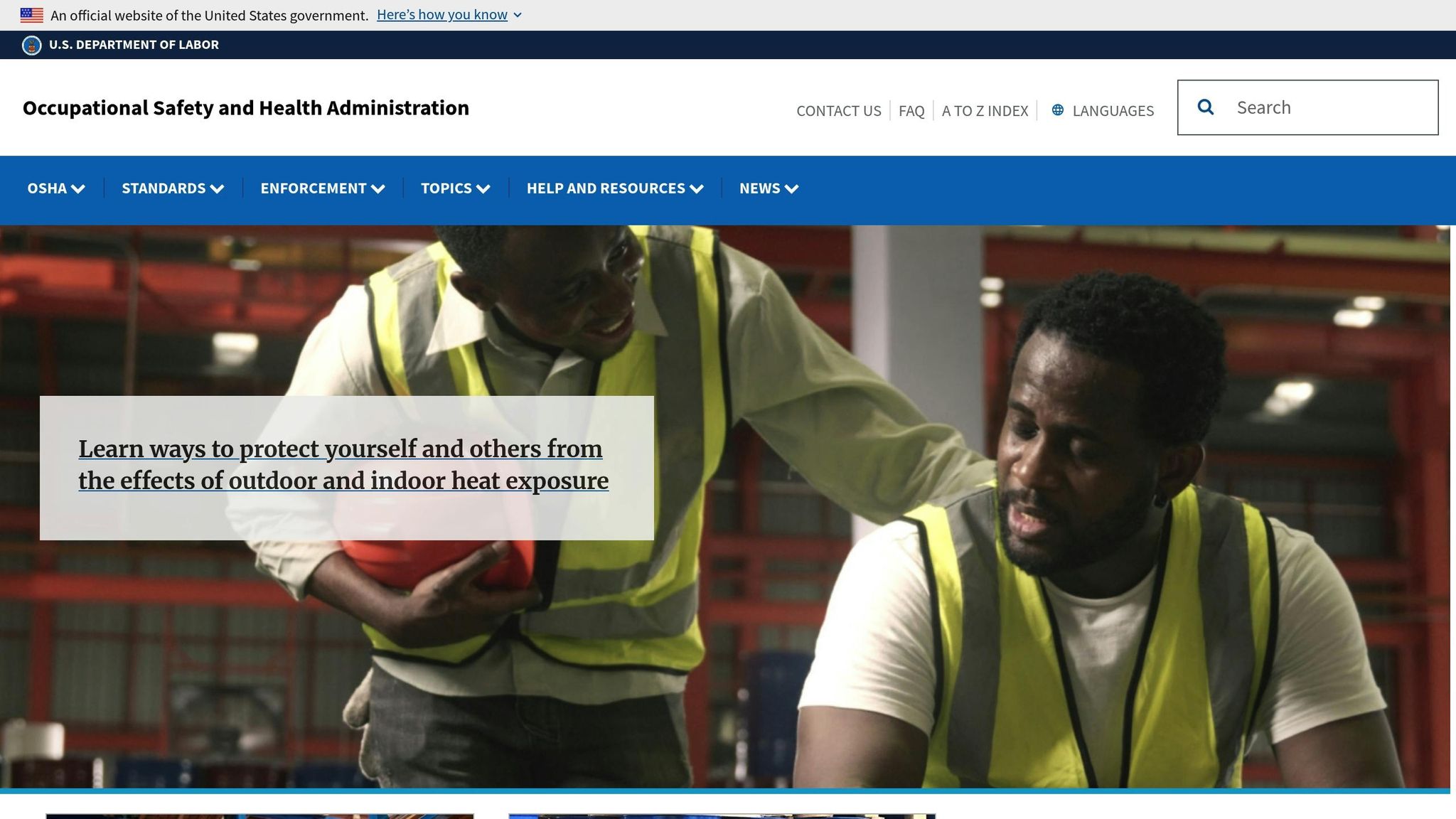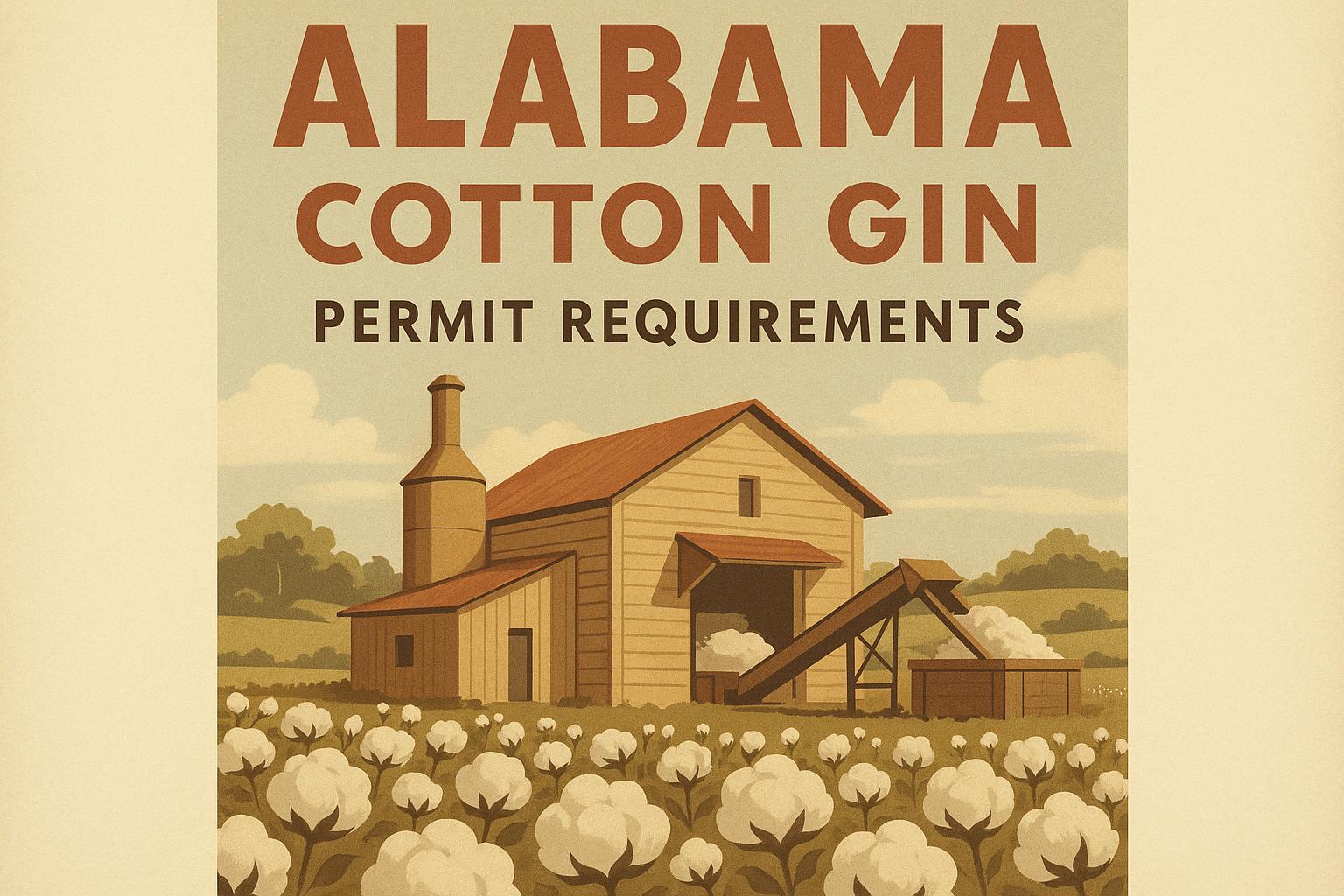Cotton ginning workers face serious health risks, especially respiratory issues caused by cotton dust exposure. Here’s what you need to know:
- Respiratory Symptoms: Workers exposed to cotton dust report 47.8% prevalence of symptoms like coughing, chest tightness, and breathing difficulties, compared to 15.3% in unexposed groups.
- Byssinosis ("Brown Lung Disease"): Common among workers, with up to 51% experiencing lung function decline.
- Dust Levels: Cotton ginning areas often exceed safe dust limits (e.g., PM-10 levels reaching 890 µg/m³) due to poor ventilation.
- Safety Gaps: Lack of proper PPE increases respiratory risks by up to 9 times, while poor education and ventilation amplify hazards.
- Long-Term Impact: Lung function declines by 5–6% per year with prolonged exposure.
Quick Facts Table
| Health Risk | Prevalence | Key Factors |
|---|---|---|
| Respiratory Symptoms | 47.8% (Exposed Workers) | Cotton dust, poor ventilation |
| Byssinosis | 51% | Chronic dust exposure |
| Chest Tightness | 30% | High dust levels |
| Coughing | 28.1% | Endotoxins, bacteria |
Key takeaway: Cotton ginning facilities must improve ventilation, enforce PPE use, and adopt modern dust control technologies to safeguard workers’ health.
Field to Feast, AWC, Harrison Farms, Yuco Cotton Gin II, 7474 N. Hwy 95, Yuma, AZ
Common Workplace Hazards in Cotton Gins
Cotton ginning facilities present serious health risks, with hazards varying significantly across different departments. Research has highlighted key dangers, especially those linked to respiratory health, underlining the need for immediate attention and action.
Cotton Dust: Sources and Exposure
Cotton dust is a mix of plant debris, fibers, bacteria, fungi, soil particles, and pesticide residues, making it a significant health concern for workers. The highest concentrations of particulate matter are found in critical processing areas:
| Department | PM-2.5 (Mean) | PM-10 (Mean) | Overall Dust Mean |
|---|---|---|---|
| Ginning | 256 µg/m³ | 820 µg/m³ | 1,076 µg/m³ |
| Pressing | 235 µg/m³ | 580 µg/m³ | 815 µg/m³ |
| Cleaning | 224 µg/m³ | 420 µg/m³ | 644 µg/m³ |
In the ginning department, PM-10 levels can spike as high as 890 µg/m³, with nearly half (47.3%) of workers reporting respiratory symptoms.
Chemical Hazards and Contaminants
Beyond dust, workers are exposed to airborne pesticide residues and bacterial endotoxins. These contaminants remain prevalent throughout the processing stages, compounding the health risks.
The absence of proper personal protective equipment (PPE) dramatically increases respiratory risks. Workers without PPE face a 9-fold higher risk, while female workers experience a 6-fold greater risk. Additionally, those with only primary or secondary education are 8 times more vulnerable.
Regulatory standards set the permissible exposure limit for cotton dust at 0.2 mg/m³ (200 µg/m³). Yet, actual dust concentrations often exceed this limit, particularly in areas with poor ventilation or during peak processing times. Addressing these hazards is essential to improving respiratory safety, as discussed in the following section.
Respiratory Health Effects
Research highlights a troubling prevalence of respiratory illnesses - up to 68.6% - among cotton gin workers, with conditions like byssinosis and reduced lung function being particularly common.
Byssinosis: Symptoms and Prevention
Byssinosis, often referred to as "brown lung disease", is a respiratory condition that tends to worsen at the beginning of the workweek. This condition is one of the most frequently reported health issues among cotton gin workers.
A detailed study compared respiratory symptoms between cotton gin workers and non-gin workers, revealing stark differences:
| Respiratory Symptom | Cotton Gin Workers | Non-Gin Workers | Statistical Significance |
|---|---|---|---|
| Chronic Cough | 50.6% | 20.4% | P ≤ 0.001 |
| Phlegm Production | 43.3% | 15.6% | P ≤ 0.001 |
| Chest Tightness | 37.3% | 12.0% | P ≤ 0.001 |
| Breathlessness | 30.1% | 12.0% | P ≤ 0.001 |
| Wheezing | 27.7% | 9.6% | P ≤ 0.001 |
These symptoms are not only more frequent but also more severe among workers exposed to cotton dust, emphasizing the need for targeted prevention measures.
Long-Term Changes in Lung Function
Extended exposure to cotton dust has a significant impact on lung health. Workers with more than 10 years of exposure show concerning declines, with 51% recording forced expiratory volume (FEV1) levels below 60% of the expected range.
One four-year study documented measurable lung function declines among gin workers:
- A 27.3 ml drop in FEV1
- A 0.21% reduction in the FEV1/FVC ratio
- A 0.058 L/s decrease in FEF25-75%
Additionally, workers exposed to cotton dust experience marked reductions in vital lung capacity metrics, including FVC, PEFR, and FEV1 (p < .001). Globally, byssinosis prevalence varies between 1% and 50%, with Egyptian ginneries reporting rates as high as 38.4% among workers and 52.6% in pressing plants [10].
These findings underscore the pressing need for better safety measures and stricter protocols to protect workers in the cotton ginning industry. The data clearly shows that prolonged exposure to cotton dust can lead to severe and lasting respiratory issues, making workplace safety improvements a critical priority.
Safety Rules and Standards
Cotton gins are required to adhere to OSHA regulations to ensure worker safety. While OSHA's cotton dust standard (§1910.1043(a)) does not apply to cotton gins due to their classification as agricultural operations, they must still comply with specific safety standards tailored to their unique hazards.
OSHA Cotton Dust Rules

Under Title 29, CFR Part 1928, OSHA regulates cotton gins, with §1928.57 addressing farm field, farmstead, and cotton gin equipment. For hazards not explicitly covered, OSHA enforces its general duty clause (Sec. 5(a)).
Key regulatory requirements include:
| Safety Aspect | Requirement | Compliance Measure |
|---|---|---|
| Equipment Guarding | Complete enclosure or location guarding | Main drive and miscellaneous drives must be fully enclosed |
| Drive Protection | Barrier installation | Guards between gin stands to prevent access |
| Emergency Systems | Audible warning devices | Required to notify workers of machinery startup |
| Maintenance Access | Secured panels and gates | Hinged top panels with positive latches |
These regulations establish the foundation for the mandatory safety equipment outlined below.
Required Safety Equipment
Cotton gins must implement rigorous safety measures and maintain equipment in accordance with OSHA standard 1928.57(d).
Essential safety equipment requirements include:
-
Machine Guards and Barriers
Guards must be constructed from materials appropriate for the moving parts they protect. For woven wire guards positioned within 2 inches of moving parts, openings cannot exceed 3/8 inch, and the material must be at least 16-gauge thick. -
Protective Barriers
Guardrails must be installed 42 inches above the working surface and include:- Midrails positioned between the top rail and the working surface
- Resistance to at least 200 pounds of force
- Full enclosures for V-belt drive pulleys
-
Emergency Systems
Audible warning systems are mandatory to alert workers before machinery starts.
"Moving saws on lint cleaners which have doors giving access to the saws shall be guarded by fixed barrier guards or their equivalent which prevent direct finger or hand contact with the saws while the saws are in motion".
Additional required safety measures include interlock systems for balers, durable covers for screw conveyors, and guards for gin saws. Shaft ends must feature smooth edges and safety sleeves, with extensions limited to half the shaft's outside diameter.
sbb-itb-0e617ca
New Safety Equipment and Methods
Recent advancements in cotton gin technology are making strides in dust control and emission reduction, addressing critical health risks for workers in ginning facilities. These innovations build on earlier safety measures, offering a more thorough approach to protecting worker health.
Cotton Cleaning Systems
Modern cleaning systems have taken a significant step forward in tackling airborne dust. Advanced dust collectors now play a key role in reducing particulate matter, which has been a persistent issue in traditional ginning operations. For example, studies reveal that particulate matter (PM-10 µm) levels in some ginning departments can reach up to 820 µg/m³.
Here’s a closer look at the technology making this possible:
| Technology | Function | Safety Benefit |
|---|---|---|
| High-Frequency Vibration | Removes impurities through targeted oscillation | Cuts down loose fiber particles in the air |
| Electrostatic Filtration | Captures microscopic dust particles | Reduces risks of respiratory issues |
| Precision Cleaning | Adapts cleaning to specific cotton types | Limits the production of excess dust |
Low-Emission Gin Equipment
To complement these cleaning advancements, new ginning equipment now incorporates emission control features designed to further protect workers. Cotton Incorporated has been at the forefront, introducing equipment that not only meets environmental standards but also prioritizes worker safety.
Here are some of the key features driving these improvements:
| Feature | Specification | Impact |
|---|---|---|
| Ventilation Systems | Integrated air handling units | Enhances removal of airborne dust |
| Sealed Components | Airtight processing chambers | Prevents particle escape during operation |
| Smart Monitoring | Real-time air quality sensors | Enables quick corrective actions to maintain safety |
"As we confront market challenges, I'm confident that our commitment to sustainability, our innovative research, and our talented team of experts will champion cotton as the fiber of choice for today's consumers and future generations."
- William Kimbrell, Cotton Incorporated CEO and President
These advancements are part of a broader effort that includes regular equipment maintenance, continuous air quality checks, integrated ventilation systems, and comprehensive worker training. Together, these measures are creating safer and healthier environments for workers in the cotton ginning industry.
Safety Resources and Support
In addition to advancements in equipment, the cotton industry relies on a network of safety resources and partnerships to uphold and enhance safety standards.
Finding Safety-Compliant Facilities
The Occupational Safety and Health Administration (OSHA) provides agricultural safety guidelines under Title 29, CFR Part 1928 (§1928.57), which serve as a critical compliance tool. Similarly, the U.S. Cotton Trust Protocol employs third-party verification to ensure facilities meet established safety benchmarks.
Industry Partnerships
Several key programs and initiatives have been developed to promote safety, including:
- USDA-ARS/NCGA Cotton Ginners Schools: Since 1986, these schools have trained over 10,625 students and certified 465 ginners since 1998.
- AgriTrust Safety Initiative: Offers tailored safety protocols specifically for cotton gin members.
- Cotton Global Disaster Solutions (Cotton GDS) HSE Policy: Focuses on safeguarding the health and safety of employees and the public.
"These annual schools are a significant outreach program to the industry and a diverse group of workers. The schools' curriculum emphasizes increasing ginning efficiency, turning out high-quality fiber, and focusing on improving safety."
- Greg Holt, research leader at the Cotton Production and Processing Research Unit in Lubbock, Texas
The National Cotton Council (NCC) also provides guidance on critical safety topics, such as powered industrial truck operation, fire prevention, module builder protocols, and insurance coverage. These resources complement on-site safety measures by promoting ongoing training and adherence to safety standards.
Through these partnerships and initiatives, the industry continues to demonstrate its dedication to prioritizing safety at every level.
Conclusion: Managing Cotton Gin Health Risks
Health risks in cotton ginning are a serious concern, with research showing that a significant percentage of workers face respiratory issues. For example, 51-71% of workers report experiencing chest tightness, while 55-62% suffer from chest pain. These statistics highlight the urgent need for targeted safety measures to protect workers in this industry.
"It was a timely reminder to the industry that sudden increases in workloads in order to meet higher production demands must be matched with an increased focus on implementing effective risk controls which are reviewed regularly to make sure they work as planned." - WorkSafe Queensland
To tackle these risks, facilities can adopt a structured approach to safety management:
| Risk Management Component | Implementation Strategy | Expected Outcome |
|---|---|---|
| Environmental Controls | Monitor and reduce dust levels, enhance ventilation systems | Lower exposure to harmful particles |
| Worker Protection | Mandate the use of PPE, provide ongoing safety training | Fewer workplace incidents |
| Medical Oversight | Schedule regular health screenings, maintain health surveillance programs | Early identification of potential health problems |
For businesses prioritizing worker safety, resources like cottongins.org offer a directory of U.S. cotton gins that adhere to safety standards. This tool complements advancements in equipment and regulatory compliance, connecting stakeholders with facilities committed to creating safer workplaces. Evidence supports that measures like improved ventilation and robust safety protocols significantly reduce health risks, proving that a comprehensive approach to safety management can make a meaningful difference.
FAQs
What steps can cotton ginning facilities take to protect workers from respiratory health risks?
To reduce respiratory health risks for workers in cotton ginning facilities, several practical steps can be taken:
- Equip workers with protective gear: Make sure employees have access to personal protective equipment (PPE) like masks or respirators that effectively filter out cotton dust.
- Enhance workplace ventilation: Install and maintain efficient ventilation systems to minimize airborne dust levels and improve air quality.
- Offer regular health check-ups: Schedule routine medical screenings to monitor workers’ respiratory health and catch potential problems early.
- Provide employee training: Educate workers on the hazards of cotton dust exposure and emphasize the importance of consistently using protective gear.
Implementing these measures can significantly improve workplace safety and help safeguard workers against the long-term effects of cotton dust exposure.
What is byssinosis, how common is it among cotton gin workers, and what are the early warning signs?
Byssinosis, commonly referred to as "Monday fever", is a respiratory condition linked to long-term exposure to cotton dust. It's a concern primarily for cotton gin workers, with research indicating that nearly half of those in the industry may experience symptoms over time. Early warning signs often include chest tightness, wheezing, and shortness of breath, which are notably worse at the beginning of the workweek.
Although byssinosis shares traits with conditions like chronic bronchitis, its cause and progression are unique. Workers noticing any symptoms should consult a healthcare professional without delay to avoid potential long-term complications. Ensuring workplace safety and using proper protective equipment can play a key role in preventing this condition.
What new technologies are helping improve air quality and reduce dust exposure in cotton ginning facilities?
Recent developments in the cotton ginning industry are making a big difference in air quality and worker safety. New dust control systems, including multi-stage cyclones and high-efficiency air filtration units, are being implemented to trap and filter dust particles during the ginning process. The result? A cleaner, safer workplace for everyone involved.
On top of that, updated conveyor systems equipped with features like hoods and filters are cutting down on airborne dust even further. These improvements not only prioritize worker health but also streamline operations, creating a more efficient and healthier environment in cotton ginning facilities.


